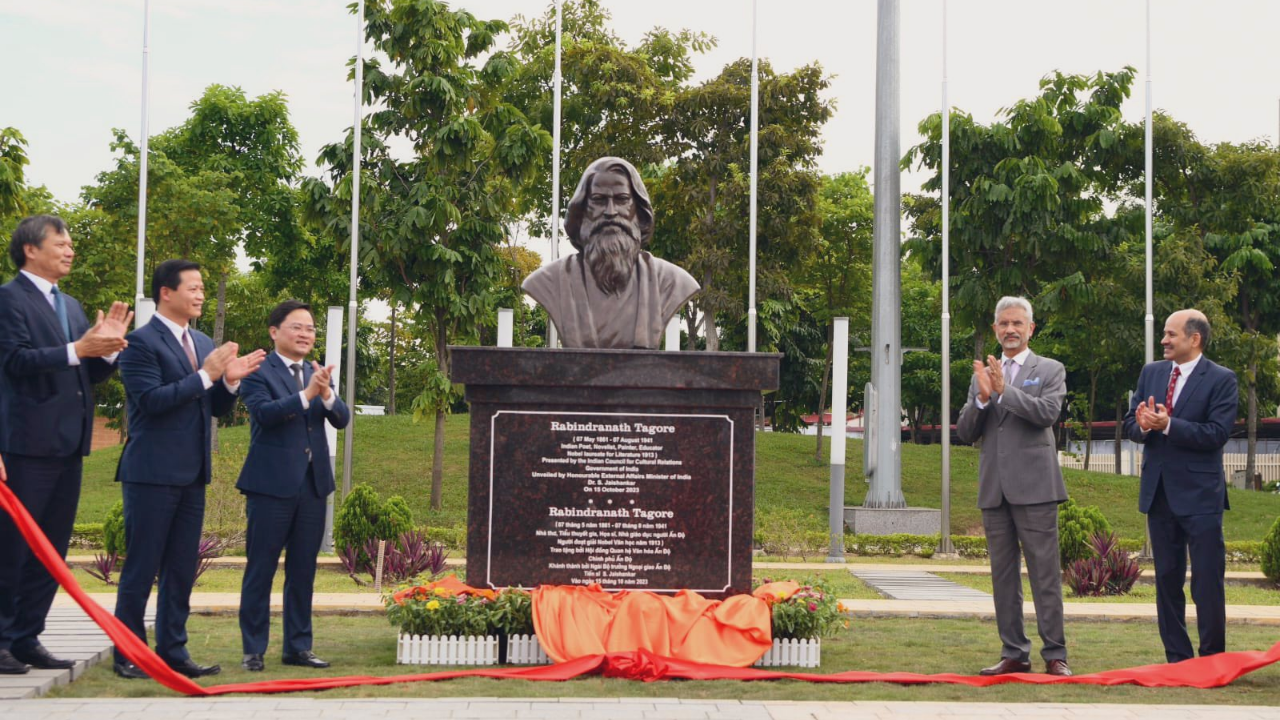Statue of Rabindranath Tagore
India and Vietnam, two nations with a shared history spanning nearly two millennia, have cultivated a remarkable bond. This connection is rooted in their history, the introduction of Buddhism, cultural exchanges, and the influence of the renowned writer and poet Rabindranath Tagore. A recent symbolic act by India’s External Affairs Minister, S. Jaishankar, inaugurated a statue of Rabindranath Tagore in Bac Ninh city, symbolizing the enduring historical and cultural ties that unite these two nations.
Historical Roots: Indian Monks and the Spread of Buddhism
Role of Indian Monks
Historical records affirm the pivotal role played by Indian monks in introducing Buddhism to Vietnam, creating the foundation for a shared spiritual heritage. This historical link through Buddhism has played a significant role in connecting the two countries on a spiritual level.
The Bodhi Tree
A living emblem of the age-old ties between India and Vietnam is the Bodhi tree, gifted by President Rajendra Prasad to President Ho Chi Minh in 1959. This enduring gift serves as a constant reminder of the profound connection between the two nations. It symbolizes their shared spiritual traditions and a lasting friendship.
Literary and Cultural Exchange: Tagore’s Influence
Gitanjali in Vietnam
Rabindranath Tagore’s famous work, “Gitanjali,” was translated into Vietnamese and published in 2001, bridging the cultural gap and bringing Tagore’s poetic brilliance to Vietnamese readers. This literary exchange has deepened the understanding of each other’s cultures and enriched the cultural relationship between the two nations.
Visit of Rabindranath Tagore
Historical records also reveal that Tagore visited Ho Chi Minh City for three days in 1929, leaving a lasting impact on Vietnam’s socio-cultural landscape. This visit contributed to the deepening of ties between the two countries and a sense of mutual respect and admiration.
Nobel Laureate
Rabindranath Tagore’s “Gitanjali” earned him the Nobel Prize for Literature in 1913, making him the first non-European to receive this esteemed award. This literary achievement continues to connect India and Vietnam through their shared appreciation for Tagore’s poetic genius. It is a testament to the profound cultural influence of Tagore’s works in Vietnam.
Celebrating Rabindranath Tagore: A Postal Stamp and a Statue
Postal Stamp Tribute
In 1982, Vietnam issued a postal stamp in honor of Rabindranath Tagore, underscoring the deep admiration and respect the nation holds for the poet. This tribute demonstrates the lasting impact of Tagore’s literary contributions and the continued reverence for his work in Vietnam.
Minister Jaishankar’s Visit
During his visit to Vietnam, External Affairs Minister S. Jaishankar expressed his deep appreciation for the reverence shown to Tagore in Vietnam. He believes that the unveiling of the Gurudev Tagore statue in Bac Ninh city will enhance the city’s international character. This act signifies the enduring relationship and mutual respect shared by both countries, fostering a promising future for their diplomatic and cultural ties.
Conclusion – Rabindranath Tagore
The historical and cultural ties between India and Vietnam have been enriched by the introduction of Buddhism, literary exchange, and the influence of Rabindranath Tagore. These bonds continue to strengthen the relationship between these two nations. The inauguration of Tagore’s statue in Bac Ninh city stands as a testament to the enduring connection and mutual respect that both countries share, cementing the deep-rooted historical and cultural ties between India and Vietnam and paving the way for a promising future of diplomatic and cultural collaboration.
- SSC JE Answer Key 2025 Out Today, Download Paper 1 Response Sheet
- Sarkari Result 2025, Latest सरकारी नौकरी Updates & Results
- OICL AO Notification 2025 Out, 300 Posts, Application Ends Today
- Bank of India Credit Officer Salary, In-Hand Pay & Allowances
- Bank of India Credit Officer Syllabus 2025, Check Exam Pattern

Priti Palit, is an accomplished edtech writer with 4+ years of experience in Regulatory Exams and other multiple government exams. With a passion for education and a keen eye for detail, she has contributed significantly to the field of online learning. Priti’s expertise and dedication continue to empower aspiring individuals in their pursuit of success in government examinations.
